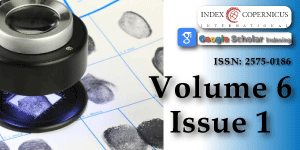Unconventional powder method is a useful technique to determine the latent fingerprint impressions
Main Article Content
Abstract
Background: Fingerprint development techniques are being used for a long time and are considered one among the oldest methods in forensic science used to identify suspects. Fingerprints are one of the most significant types of physical evidence. There are various types of fingerprint patterns such as visible, plastic and latent. In criminal investigation cases, chance fingerprint impressions are mostly found at the crime scene. These prints are generally invisible and therefore require several development methods. The powder dusting technique of developing fingerprints involves the application of fine powder on the impression of the print with the help of a brush such as glass fiber or a camel hair brush.
Main text: This paper rather focuses on various unconventional powder methods than the widely used conventional ones. This will help identify other cheaper, non-toxic powders that are commonly available as an alternative to the expensive, toxic ones. The author’s main aim is to provide a collective review of the work of other scientists in order to identify everyday materials, commonly available that can be used as possible means to develop a fingerprint impression.
Conclusion: For a better result, the unconventional powder is used on different surfaces i.e. porous, non-porous, and semi-porous for latent fingerprint impressions. After developing impressions on different surfaces, we conclude our result that unconventional powder is very useful.
Article Details
Copyright (c) 2022 Niranjan H, et al.

This work is licensed under a Creative Commons Attribution 4.0 International License.
Garg R, Kumari H, Kaur R. A new technique for visualization of latent fingerprints on various substrates using powder from turmeric: A rhizomatous herbaceous plant (Curcuma longa). Egyptian Journal of Forensic Science. 2011; 1: 53-57.
Nigam K, Das T, Harshey A, kumar A, Kapoor N, Yadav V, Srivastava A. Effectiveness of Talcum powder for decipherment of latent fingerprint on various substrates. Asian Journal of Chemistry. 2021.
Thakur P, Garg R. New developing reagent for latent finger mark visualization: Fuller’s earth. Egyptian Journal Forensic Science. 2016. 6: 449-58.
Champod C, Lennard C, Margot P, Stoilovic M. Fingerprints and other ridge skin Impressions, Chapter 4. CRC Press, Washington D.C; 2004.
Garg RK. Latent fingerprints in forensic science. In: Veeraraghavan V, editor. Handbook of forensic science. New Delhi: Selective and Scientific Books Publishers; 2004; 77-85.
Saroa JS, Sodhi GS, Garg RK. Evaluation fingerprint powders. J Forensic Ident. 2006; 56(2):186-197.
Mia R, Panchal V, Gokhale C. Using Salt & Sugar Powder to Development Hidden Fingerprint Impressions at the Crime Scene. International Journal of Forensic Sciences. 2021; 6(2).
Rohatgi R, Kapoor AK. New Visualizing Agents for Developing of the Latent Fingerprints on the Various Porous and Non-Porous Surfaces by Using Different Household Food Items. Asian Journal of Science and Applied Technology. 2014; 3(2): 33-38.
Badiye A, Kapoor N. Efficacy of Robin® powder blue for the latent fingerprints development on the surfaces. Egyptian Journal of Forensic Science. 2015; 5(4):166-173.
Thakur P, Garg RK. New developing reagent for the latent fingermark visualization: Fuller earth. Egyptian Journal of Forensic science. 2016; 6(4): 449-458.
Dhunna A, Anand S, Aggarwal A, Agarwal A, Verma P, Singh U. New visualization agents to reveal the hidden secrets of the latent fingerprint. Egyptian Journal of Forensic Science. 2018; 8(1): 1-6.
Kumari H, Kaur R, Garg RK. New Visualizing agents for the latent fingerprints: Synthetic food and festival color. Egyptian Journal of Forensic Science. 2011; 1(3-4): 133-139.
Singh K, Sharma S, Garg RK. Visualization of latent fingerprints using the silica Gel: new technique. Egyptian Journal of Forensic Science. 2013; 3(1): 20-25.
Ferguson S, Nicholson L, Farrugia K, Bremner D, Gentles D. A preliminary Investigation onto a acquisition of fingerprints on Foods. Science & Justice. 2013; 53(1), 67-72.
Herschel WJ. Skin furrows of the hand. Nature. 1880; 23:76.

